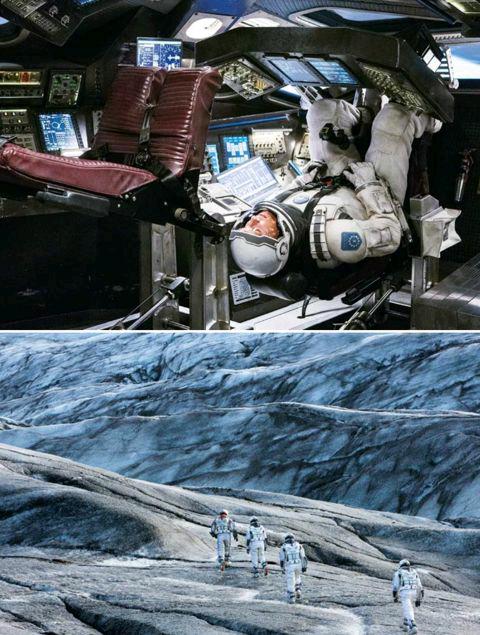Stellar Nature of Interstellar
by+Han+Song
American sci-fi films ranging from 2001: A Space Odyssey and Prometheus to Gravity and Interstellar all took spectatorsbreath away. Each film set a new standard, eclipsing the seeming perfection of the last. And Interstellar may be the best yet.
First, it presents stunning spectacle. Director Christopher Nolan builds an imaginary world with his camera. Assuming that creatures in quintuple space have produced an alien land, Nolan successfully produces this land as visual images for his audience. Transforming imagination into reality on the big screen is a major ingredient in science fiction films historical strong box office performances. Theoretical concepts such as wormholes and black holes, which could previously only be observed through math, have now been depicted visually in cinemas. In the film, giant waves and frozen rocks on superior planets are no longer only theory, but humanitys destined future. Many shots in the film are reminiscent of 2001: A Space Odyssey. The robot in Interstellar, whose distinctive personality often mirrors the hero, seems to be Nolans salute to Kubricks masterpiece. At the same time, film versions of robots have evolved and witnessed breakthroughs. Kubricks 2001 hit big screens in 1968, breaking new ground in cinematography with innovative visual effects and creating a benchmark for scientific realism in his generation. At the end of Interstellar, the scene where people in quintuple space send messages to each other using gravity to break down barriers of time and space also impressed many. Contrasting novels, film must present its audience with visual imagery. With the development of technology, it has become possible to turn every “impossibility” of science fiction into visual reality.
Its second key ingredient is love. Humanity lies at the core of Interstellar. Humanity and science fiction elements are woven together to push the story. The movie spares no efforts to depict love among friends, lovers, and family, especially the relationship between father and daughter. These emotions become even stronger when they are complemented by science fiction. The greatest charm of science fiction lies in the revelation of universal human nature, after placing humans in extreme conditions. In Interstellar, the younger generation on earth ages very quickly, while the older generation in space remains young. Thus, during a short conversation between an astronaut father and his son on earth, the son matures and grows a long beard in an instant. At the end, the scene of the still-young hero seeing his “little girl” for the last time, who has become an elderly lady, moves many to tears. The movie also vividly portrays many figures, like an astronaut on an interstellar voyage who is on the verge of a mental break down due to loneliness.
The third factor is philosophy. It is very important that science fiction films manifest some philosophy. Interstellar depicts ultimate concern for human destiny. In the film, all advanced technologies on earth cannot save humanitys doomed fate. Since people are becoming extinct, they must find new homes on other planets. This is the reason they spend so much time discussing the meaning of outer space exploration. During its three-hour narration, Interstellar discusses how lonely humans face the universe and finally walk towards it. The movie exhibits a whole dif- ferent “world” outside earth, which makes the audience ponder and reflect on their present days and “experience” their future in advance. The movie vividly portrays the cruelty of the universe and reality of peoples fears. In outer space, collectivism replaces and surpasses individualism. When real crisis arrives, human beings as a whole are abandoned. Only very few elites survive as “seeds” of human beings. The movie depicts the possibilities of people evolving into a more advanced level, a kind of creature living in quintuple space. Then, who will rescue humanity? The movie gives one answer: Not aliens, but human beings themselves. Human beings reach a sort of God-like existence, and rescue themselves from the future. However, even God himself needs to fulfil his mission through individuals, which in the religious sense requires self-salvation first. From this perspective, the movie deals with issues concerning spirituality. The daughter believes her father will finally come back one day, just like she believes in the second coming of Christ. Thus, the hero Cooper resembles a kind of personification of Christ. And dead bodies strewn on other planets and the hero and heroine floating through outer space all exhibit images of the cross. In this sense, I think all science fiction films are religious in nature. Although I watched the movie in a cinema in downtown Beijing, I felt I was at church.
Actually, I still cannot fully understand why American sci-fi filmmakers made this movie three hours and cast only big names. I even doubt earning money is the biggest motivation behind this movie. Perhaps its looking to lure more people away from earth.
China Pictorial2015年1期
